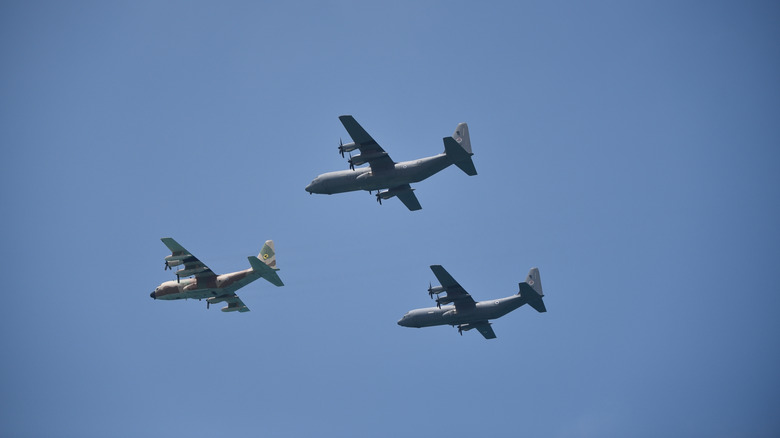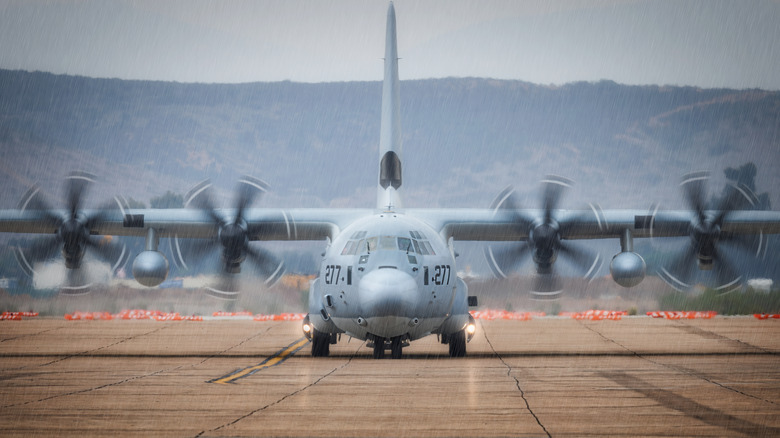
The C-130 Hercules is like the Swiss Army knife of aviation. Built by Lockheed Martin, this reliable and versatile aircraft holds the Guinness World Record for being the longest continuously produced military cargo plane in history. Over 2,600 C-130s have rolled out of Lockheed Martin's Marietta, Georgia facility since beginning its service in 1956. Evolving over time, it's undergone numerous upgrades to meet the challenging needs of military forces worldwide.
Originally built to carry military troops
and cargo into combat zones, the Hercules quickly proved itself far more capable. From tactical airlifts, humanitarian relief, and aerial firefighting, the C-130 has been able to fulfill every role required, even serving as a fearsome gunship.
It's known for being rugged and able to land on short, dirt, or damaged runways that would ground most other large planes. That kind of operational flexibility is exactly why, close to 70 years of action, the Hercules remains in high demand. Many nations' air forces consider it an essential part of operations because of the C-130's blend of durability and mission adaptability.
Read more: 11 Of The Most Iconic Ground Attack Military Planes In History
How Many C-130s Are Flying Today And Where?

There are roughly 1,500 to 1,600 C-130 aircraft still flying across the globe. The United States has the largest fleet by far, with over 270 operated by the Air Force, plus dozens more used by the Marines, Navy, Coast Guard, and even the National Oceanic and Atmospheric Administration (NOAA) for storm tracking. Around 70 other countries use the Hercules, solidifying its place as a truly global platform. Australia flies a growing fleet of C-130J-30s, India and Indonesia depend on the Hercules for reaching remote regions, and the UK and Canada count on it for NATO operations.
What keeps so many nations committed is simple: Few aircraft can reliably deliver heavy payloads into unimproved or disaster-struck airfields with such low operating costs. There's built-in long-term value in upgrading existing Hercules fleets instead of buying new ones, taking advantage of modern avionics and engine retrofits. This helps stretch budgets while keeping crews trained on a proven airframe, allowing the C-130 to remain mission-ready for decades to come.
The C-130J Keeps The Legend Alive

Lockheed Martin's modern C-130J Super Hercules is the clearest sign that this aircraft isn't just resting on its laurels. The J model has powerful new engines, a digital flight deck, and systems that cut the required crew from five to three, lowering operating costs while increasing mission readiness. Lockheed Martin's Georgia production line still churns out about 20 C-130Js a year, fulfilling fresh orders from Australia, Egypt, Sweden, and other nations that still require its capabilities, but without the cost of brand-new airlifter designs.
These upgrades also ensure that maintenance stays simpler, keeping older Hercules in service alongside the new builds. Modernizing the C-130 and maintaining its rugged airframe hasn't slowed global demand, meaning it's on track to fly well into the 2030s. For militaries with smaller budgets and unpredictable conflicts, evolving a trusted platform can be smarter than starting from scratch, effectively making the C-130 Hercules a living legend of the skies.
Want the latest in tech and auto trends? Subscribe to our free newsletter for the latest headlines, expert guides, and how-to tips, one email at a time.
Read the original article on SlashGear.












